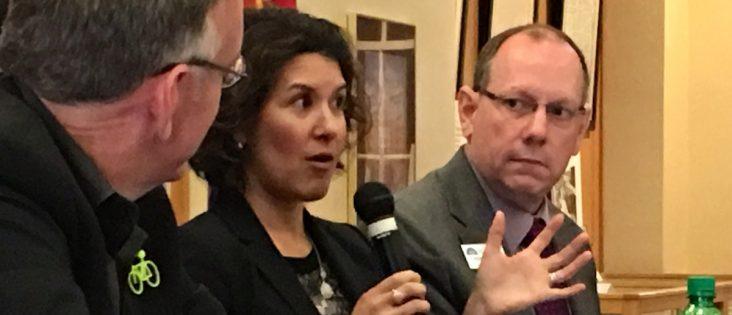Panelist: Downtowns offer ‘local distinctiveness,’ can be a ‘microcosm of democracy’
by March 28, 2016 9:19 pm 245 views

Karen Minkel, director of the Walton Family Foundation’s Home Region, speaks while Victor Dover, (left) a principal in the Florida-based planning firm Dover, Kohl & Partners, and Greg Phillips, director of Main Street Arkansas, listen.
The United States made a mistake when it emphasized “all driving all the time” over downtown areas, and communities and state and local governments should correct that mistake, said a panelist in a discussion at the Clinton School of Public Service Monday.
Victor Dover, a principal in the Florida-based planning firm Dover, Kohl & Partners, said the Arkansas Highway and Transportation Department should remove the “Highway” from its name, like most states have done, and should rework its objectives. Instead of trying to see how much free-flowing traffic can be serviced at peak hour, it should study how many vehicle miles traveled per person it can eliminate. Building more lanes just induces more traffic, he said.
Also, local communities can eliminate minimum parking requirements, which result in buildings sitting on half-empty parking garages, and minimum lot sizes, which encourage big developments rather than smaller ones, he said.
Gabe Holstrom, executive director of the Downtown Little Rock Partnership, said the Legislature can increase tax credit limits created by 2009 legislation. The Boyle Building in Little Rock would cost $20 million to renovate, but a developer would receive only a $120,000 tax credit. In Mississippi, that same developer would receive a $5 million tax credit.
Dover said communities wanting to revitalize their downtowns can start with attractions and amenities to draw tourists, or they can start small with a downtown Christmas tree lighting or a Fourth of July parade. He said when a community is just starting and there is only a faint pulse, don’t add a bunch of rules. Instead, pound the chest to get a heartbeat, he said.
Beginning in 1939, he said society attempted a massive experiment, never before tried, that changed the way people lived in cities. People were made to live in a car-based society with central downtown business districts separated by homes requiring a commute to reach.
“And no surprise, the 20th century ended, and people are flowing back into the more natural habitat,” he said.
Karen Minkel, director of the Walton Family Foundation’s Home Region, said a downtown is a “microcosm of democracy.” She said one of the four strategies for developing the Northwest Arkansas region is preserving a sense of place, and downtown revitalization is a big part of that strategy.
Greg Phillips, director of Main Street Arkansas, said every successful downtown development has included a historic preservation effort.
Dover agreed with that assessment. He said in the past, historic preservationists were the “shock troops of urban revitalization.” Now other groups are contributing, including cyclists, who want shorter commutes and slower street flow. Dover said there was a period of time when shopping malls had all the momentum because they were the best at offering good parking and air-conditioning in the area between storefronts. What they produced, however, was commodity real estate where every square foot was like every other one. Downtowns compete on “local distinctiveness,” he said.
“You’re no longer competing to see how cheaply you can deliver commodity real estate,” he said. “You’re seeing how expressively you have a lot of cool to a place, and people will choose it even if they have to go farther to get to it or even pay a little more per square foot for it.”
Dover said he doesn’t hate cars and that he drives his car often, but he doesn’t want to be a slave to it. Driving should be a choice, he said.
